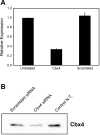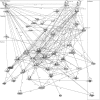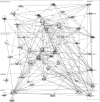Contribution of CBX4 to cumulus oophorus cell phenotype in mice and attendant effects in cumulus cell cloned embryos
- PMID: 24280258
- PMCID: PMC3921348
- DOI: 10.1152/physiolgenomics.00071.2013
Contribution of CBX4 to cumulus oophorus cell phenotype in mice and attendant effects in cumulus cell cloned embryos
Abstract
Cumulus oophorus cells play an essential role in oocyte development. They are also widely employed as donor cells for cloning by somatic cell nuclear transfer. Our previous studies revealed that Cbx4 mRNA was overexpressed in cloned two-cell embryos. These data indicated that CBX4 may regulate normal cumulus cell differentiation and that its overexpression in clones could contribute to aberrant gene regulation. We used siRNA-mediated knockdown of Cbx4 to assess its role in determining cumulus cell phenotype and compared the effects of this knockdown to published data for aberrant gene regulation in cloned embryos. We observed widespread effects on the expression of genes related to diverse processes in cultured cumulus cells, including cell assembly/proliferation and DNA replication/repair, endocrine function, carbohydrate and lipid metabolism, inflammation, and cell morphology, with apparent effects of CBX4 in promoting cumulus cell proliferation and survival and inhibiting differentiation. Overall, the data implicate CBX4 as a key component in the pathway integrating endocrine signals, intraovarian paracrine factors, and oocyte-derived factors in the control of cumulus cell functions. We also observed altered expression of 25 cumulus cell markers of oocyte quality, indicating an important role of CBX4 in production of high quality oocytes. Finally, we found that about one-quarter of the genes showing aberrant transcription in cloned embryos are sensitive to Cbx4 knockdown in cumulus cells, consistent with a role for aberrant Cbx4 regulation in elaborating abnormal cloned embryo characteristics.
Keywords: chromatin; cloning; differentiation; follicle; nuclear reprogramming; ovary; polycomb; somatic cell nuclear transfer.
Figures






References
-
- Ackert CL, Gittens JE, O'Brien MJ, Eppig JJ, Kidder GM. Intercellular communication via connexin43 gap junctions is required for ovarian folliculogenesis in the mouse. Dev Biol 233: 258–270, 2001 - PubMed
-
- Adriaenssens T, Wathlet S, Segers I, Verheyen G, De Vos A, Van der Elst J, Coucke W, Devroey P, Smitz J. Cumulus cell gene expression is associated with oocyte developmental quality and influenced by patient and treatment characteristics. Hum Reprod 25: 1259–1270, 2010 - PubMed
-
- Assidi M, Dieleman SJ, Sirard MA. Cumulus cell gene expression following the LH surge in bovine preovulatory follicles: potential early markers of oocyte competence. Reproduction 140: 835–852, 2010 - PubMed
-
- Assidi M, Dufort I, Ali A, Hamel M, Algriany O, Dielemann S, Sirard MA. Identification of potential markers of oocyte competence expressed in bovine cumulus cells matured with follicle-stimulating hormone and/or phorbol myristate acetate in vitro. Biol Reprod 79: 209–222, 2008 - PubMed
Publication types
MeSH terms
Substances
Associated data
- Actions
Grants and funding
LinkOut - more resources
Full Text Sources
Other Literature Sources
Molecular Biology Databases

